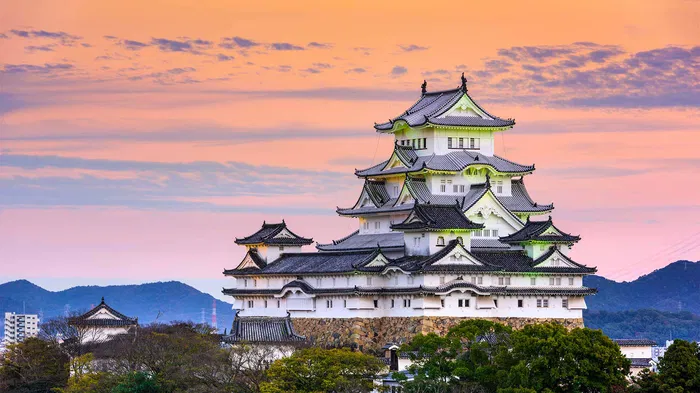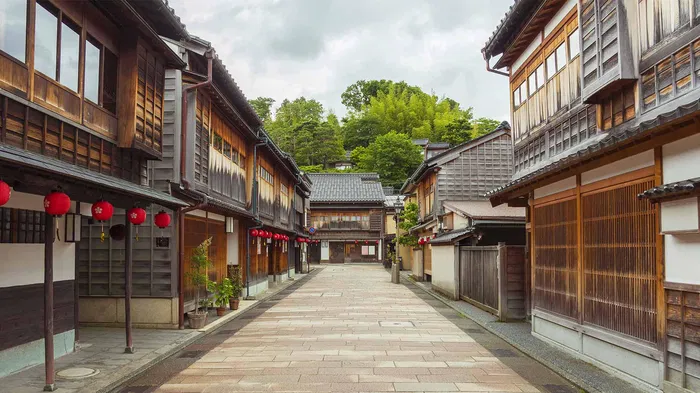On your travels to Japan or in reels on Instagram, you may have seen images of delicate and intricate traditional Japanese sweets. These are called wagashi, and they are absolutely delicious.
Commonly paired with green tea, wagashi sweets have been part of Japanese culture for thousands of years. Read on for a quick look at the history of wagashi, what wagashi is made of (hint: rice is key), popular types of wagashi—and where you can try them.
Learn how to make Japanese sweets at a hands-on wagashi class in Tokyo!
What Is Wagashi?
Wagashi is a type of traditional Japanese sweet. It is crafted using a variety of ingredients, including rice flour, sugar, and sweet beans such as adzuki (red beans) or white bean paste. A lot of types of wagashi are often vegetarian or even vegan, as well as gluten free, at least when they are made the old-fashioned way.
Wagashi sweets are typically paired with green tea and are deeply rooted in Japanese culture. They are often associated with tea ceremonies and special occasions, and may be given as gifts.
The aesthetic principles of simplicity, balance and harmony are often reflected in the design and presentation of wagashi. Wagashi also reflects a connection to nature, and as such the designs change throughout the year to reflect the changing of the seasons.
For another popular type of Japanese sweet, see our guide to "purin".
A Brief History of Wagashi
Wagashi has a long history that intertwines with the influence of Buddhism, the introduction of sugar and the cultivation of tea in Japan. The first forms of wagashi were actually offerings of fruits and nuts to deities and spirits. This then evolved into offering rice cakes and mochi—sweets made from pounded rice.
With the introduction of Buddhism came an influx of monks, who brought over with them confectionary-making techniques from China. This had a significant impact on the creation of new sweets in Japan.
During the Muromachi period (14th to 16th century), tea ceremony grew in popularity among the elite. Simple sweets were served alongside the tea to balance out the bitter taste. When matcha was introduced to tea ceremonies, this further shaped the development of wagashi and led it to become an integral part of the ceremony.
In the Edo period (17th to 19th centuries), the cultivation of sugar cane in Okinawa and the increased availability of refined sugar led to the creation of new types of wagashi. It was also during this time that red beans, known as adzuki, became more widely used in wagashi, leading to its distinct flavor and texture.
Dedicated wagashi-makers also emerged during this period, creating intricate designs and incorporating seasonal motifs into their creations. During the Meiji period (late 19th century), Japan underwent a period of modernization and Western influence started to appear in Japanese culture. Despite the introduction of Western-style desserts however, wagashi has managed to maintain its cultural significance and popularity.
What Is Wagashi Made Of? Main Ingredients in Wagashi
Despite all of the variations of Japanese wagashi available, most wagashi are made from the following combination of ingredients:
- Red bean paste (anko)
- White bean paste (shiroan)
- Sugar
- Rice flour
Red bean paste, known as anko in Japanese, is a type of sweet filling made from a mixture of boiled adzuki beans and sugar. It is a central ingredient in many famous Japanese confections like mochi, dorayaki and taiyaki. Red bean paste can have different textures, from smooth and creamy or chunky.
The rice flour used in wagashi adds a soft and chewy texture to the dessert, and sugar is used to sweeten both the bean paste and dough.
Wagashi also incorporates natural flavorings such as matcha, yuzu (a type of citrus fruit), cherry blossoms and a variety of seasonal fruits and flowers.
The world of wagashi is a diverse one, and there are countless variations and regional specialties throughout Japan, with each wagashi-maker adding their own unique spin.
How To Make Wagashi
To make wagashi, you first have to prepare all of the ingredients. The two core components of wagashi are the bean paste and the dough. Making the bean paste means cooking the beans until soft and then mashing them together before putting them through a strainer to produce a smooth bean paste.
In a pot, you then add the bean paste, sugar and salt and heat until it becomes a moldable paste.
For the dough, you have to combine rice flour, water and sugar in a pot over heat and stir, stir, stir! The bean paste is then added and stirred until a moldable dough forms. From here, it is then up to you to shape the dough as you like.
Traditional wagashi-makers use a variety of molds and shaping tools to create the intricate designs of wagashi. Some of these tools include nerikiri kobo, a wooden mold often carved into various seasonal designs. Koshi-an kobo are special wooden molds used specifically for shaping the bean paste into various forms.
Finally, there is kashigata, which are used to imprint designs onto the wagashi. The mold is pressed onto the surface of the pastry dough or paste, creating a beautiful embossed design.
Wagashi-making Experiences in Japan
Now that you know all about wagashi, what about making some yourself? There are a variety of classes available, from beginner to expert level. Here are two of the most popular:
Tokyo Wagashi-making Class With Tea Ceremony
Conveniently located in Tokyo, in this wagashi-making class you will learn how to make three traditional Japanese sweets including the popular nerikiri wagashi, daifuku mochi and dango mochi.
Kyoto Wagashi-making Class With Tea Ceremony
If you’re looking to dive deep into the traditional side of Kyoto, this wagashi-making experience allows you to not only make wagashi, but also to try world-class, locally grown green tea. In this all-inclusive class, you will make four kinds of wagashi, and also learn how to make your own bowl of matcha—plus the etiquette for drinking green tea and the spirit of Japanese tea ceremony.
Types of Wagashi
Below are some of the most common types of wagashi that you are likely to see when in Japan:
- Namagashi: Fresh, delicate wagashi made with seasonal ingredients. They often have a soft texture and are beautifully designed. Namagashi is the sweet most often associated with wagashi.
- Daifuku: A type of mochi (soft rice cake) that is filled with sweet bean paste, typically made with adzuki beans.
- Mitarashi dango: Skewered mochi dumplings drizzled with a sweet soy sauce glaze. They are often enjoyed as a street food snack.
- Dorayaki: Two pancake-like patties sandwiching a sweet-bean-paste filling.
- Taiyaki: A fish-shaped pastry made from a pancake-like batter and filled with sweet bean paste or other fillings like custard or chocolate (or even wasabi!).
- Yokan: A firm, jelly-like sweet made from red bean paste, sugar, and agar. Yokan can have various flavors and may contain additional ingredients like chestnuts or fruit.
- Sakura mochi: A seasonal wagashi enjoyed during cherry blossom season. It consists of a pink-colored mochi wrapped around sweet bean paste and a pickled cherry blossom leaf.
- Higashi: Dry, delicate wagashi often served during tea ceremonies. Higashi are intricately designed sugar-based sweets that come in various shapes and patterns.
How To Eat Wagashi
Wagashi can be enjoyed in different ways, depending on personal preferences and the specific type of wagashi being served. Here are some common ways to eat wagashi:
- With tea: Traditionally, wagashi is enjoyed with a cup of green tea, often during a Japanese tea ceremony or as a part of a tea gathering. The combination of the bitter tea and the sweet wagashi creates a harmonious balance of flavors. The tea is sipped to cleanse the palate before taking a bite of wagashi, allowing the subtle sweetness and textures to be savored.
- On its own: Some wagashi, particularly those with a soft or jelly-like texture, can be enjoyed on their own as a standalone sweet.
- Paired with other desserts: Wagashi can be paired with other desserts or enjoyed alongside Western-style sweets. For example, a piece of wagashi can be served alongside a scoop of ice cream or enjoyed with a slice of cake, providing a contrast in flavors and textures.
- Seasonal occasions: Certain types of wagashi are associated with specific seasons or festivals. They are often enjoyed during those particular times. For example, sakura mochi is traditionally eaten during cherry blossom season, while yomogi mochi (made of Japanese arrowroot) is enjoyed in spring. By consuming wagashi during these seasonal occasions, it enhances the experience and cultural significance of the sweet.
It's important to note that wagashi is meant to be appreciated not only for its taste but also for its visual beauty and cultural significance. When eating wagashi, take your time to admire the intricate designs, savor the flavors, and enjoy the overall experience of this traditional Japanese sweet!
Where To Buy Wagashi in Japan
Wagashi can be bought throughout Japan, depending on what kind you are looking for. Wagashi shops tend to stock the more traditional namagashi and yokan, while other confections like dorayaki, taiyaki and manju can be found in supermarkets and even convenience stores. See a list of popular wagashi shops in Tokyo.
FAQ: Is Wagashi the Same as Mochi?
No. Despite common misunderstandings, wagashi is not the same as mochi. Mochi is a type of wagashi, though.
Mochi refers specifically to a type of wagashi that is made from pounded glutinous rice, also known as mochigome. Wagashi is the broader category that includes all traditional Japanese sweets. So—mochi is just one type of wagashi; there are many other types of wagashi beyond mochi.
 Tokyo
Tokyo Osaka
Osaka Kyoto
Kyoto Hyogo
Hyogo Hokkaido
Hokkaido Nara
Nara Fukuoka
Fukuoka Hiroshima
Hiroshima Kanagawa
Kanagawa Ishikawa
Ishikawa Florence
Florence Paris
Paris Rome
Rome Porto
Porto Barcelona
Barcelona New York
New York Venice
Venice Madrid
Madrid Marrakesh
Marrakesh Istanbul
Istanbul